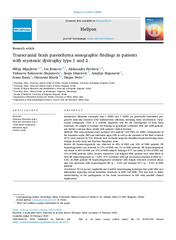Приказ основних података о документу
Transcranial brain parenchyma sonographic findings in patients with myotonic dystrophy type 1 and 2
| dc.creator | Mijajlovic, Milija | |
| dc.creator | Bozovic, Ivo | |
| dc.creator | Pavlović, Aleksandra | |
| dc.creator | Rakocevic-Stojanovic, Vidosava | |
| dc.creator | Gluscevic, Sanja | |
| dc.creator | Stojanovic, Amalija | |
| dc.creator | Basta, Ivana | |
| dc.creator | Meola, Giovanni | |
| dc.creator | Peric, Stojan | |
| dc.date.accessioned | 2024-02-26T11:56:36Z | |
| dc.date.available | 2024-02-26T11:56:36Z | |
| dc.date.issued | 2024 | |
| dc.identifier.issn | 2405-8440 | |
| dc.identifier.uri | https://www.sciencedirect.com/science/article/pii/S2405844024028871 | |
| dc.identifier.uri | internal-pdf://2340/S2405844024028871.html | |
| dc.identifier.uri | http://rfasper.fasper.bg.ac.rs/handle/123456789/5409 | |
| dc.description.abstract | IntroductionMyotonic dystrophy type 1 (DM1) and 2 (DM2) are genetically determined progressive muscular disorders with multisystemic affection, including brain involvement. Transcranial sonography (TCS) is a reliable diagnostic tool for the investigation of deep brain structures. We sought to evaluate TCS findings in genetically confirmed DM1 and DM2 patients, and further correlate these results with patients’ clinical features.MethodsThis cross-sectional study included 163 patients (102 DM1, 61 DM2). Echogenicity of the brainstem raphe (BR) and substantia nigra (SN) as well as the diameter of the third ventricle (DTV) were assessed by TCS. Patients were evaluated using the Hamilton Depression Rating Scale, Fatigue Severity Scale and Daytime Sleepiness Scale.ResultsSN hyperechogenicity was observed in 40% of DM1 and 34% of DM2 patients. SN hypoechogenicity was detected in 17% of DM1 and 7% of DM2 patients. BR hypoechogenicity was found in 36% of DM1 and 47% of DM2 subjects. Enlarged DTV was noted in 19% of DM1 and 15% of DM2 patients. Older, weaker, depressive, and fatigued DM1 patients were more likely to have BR hypoechogenicity (p < 0.05). DTV correlated with age and disease duration in DM1 (p < 0.01). In DM2 patients SN hyperechogenicity correlated with fatigue. Excessive daytime sleepiness was associated with hypoechogenic BR (p < 0.05) and enlarged DVT (p < 0.01) in DM2 patients.ConclusionsTCS is an easy applicable and sensitive neuroimaging technique that could offer new information regarding several brainstem structures in DM1 and DM2. This may lead to better understanding of the pathogenesis of the brain involvement in DM with possible clinical implications. | |
| dc.language | en | |
| dc.publisher | Elsevier | |
| dc.relation | info:eu-repo/grantAgreement/MESTD/Basic Research (BR or ON)/175083/RS// | |
| dc.rights | openAccess | |
| dc.rights.uri | https://creativecommons.org/licenses/by-nc-nd/4.0/ | |
| dc.source | Heliyon | |
| dc.source | HeliyonHeliyon | |
| dc.subject | Myotonic dystrophy type 1 | |
| dc.subject | Myotonic dystrophy type 2 | |
| dc.subject | Nucleus raphe | |
| dc.subject | Substantia nigra | |
| dc.subject | Transcranial sonography | |
| dc.subject | Myotonic dystrophy type 1 | |
| dc.subject | Myotonic dystrophy type 2 | |
| dc.subject | Transcranial sonography Substantia nigra | |
| dc.subject | Nucleus raphe | |
| dc.title | Transcranial brain parenchyma sonographic findings in patients with myotonic dystrophy type 1 and 2 | |
| dc.type | article | en |
| dc.type | publicVersion | |
| dc.rights.license | BY-NC-ND | |
| dc.citation.issue | 5 | |
| dc.citation.spage | e26856 | |
| dc.citation.volume | 10 | |
| dc.identifier.doi | 10.1016/j.heliyon.2024.e26856 | |
| dc.identifier.fulltext | http://rfasper.fasper.bg.ac.rs/bitstream/id/11113/1-s2.0-S2405844024028871-main.pdf | |
| dc.type.version | publishedVersion |


